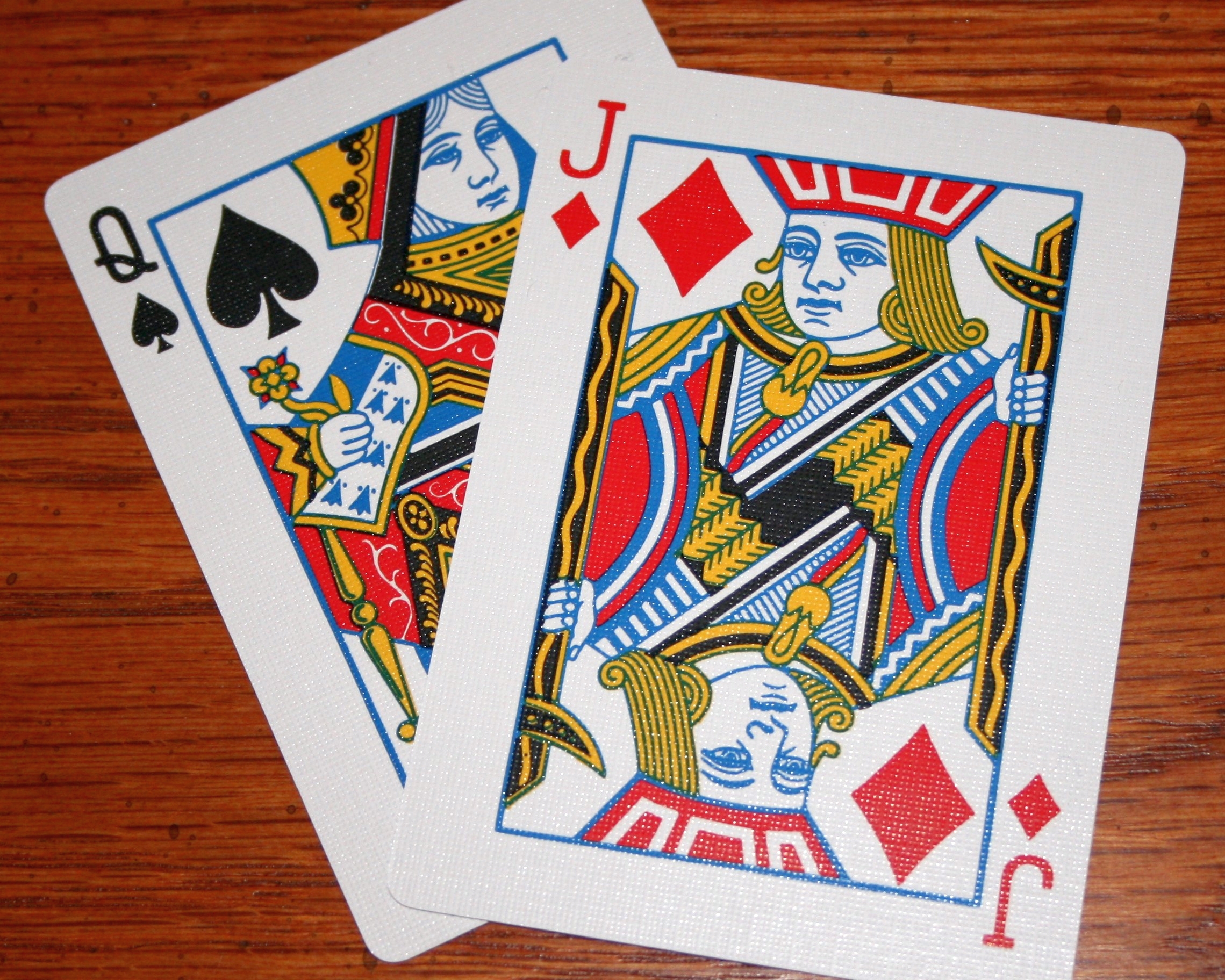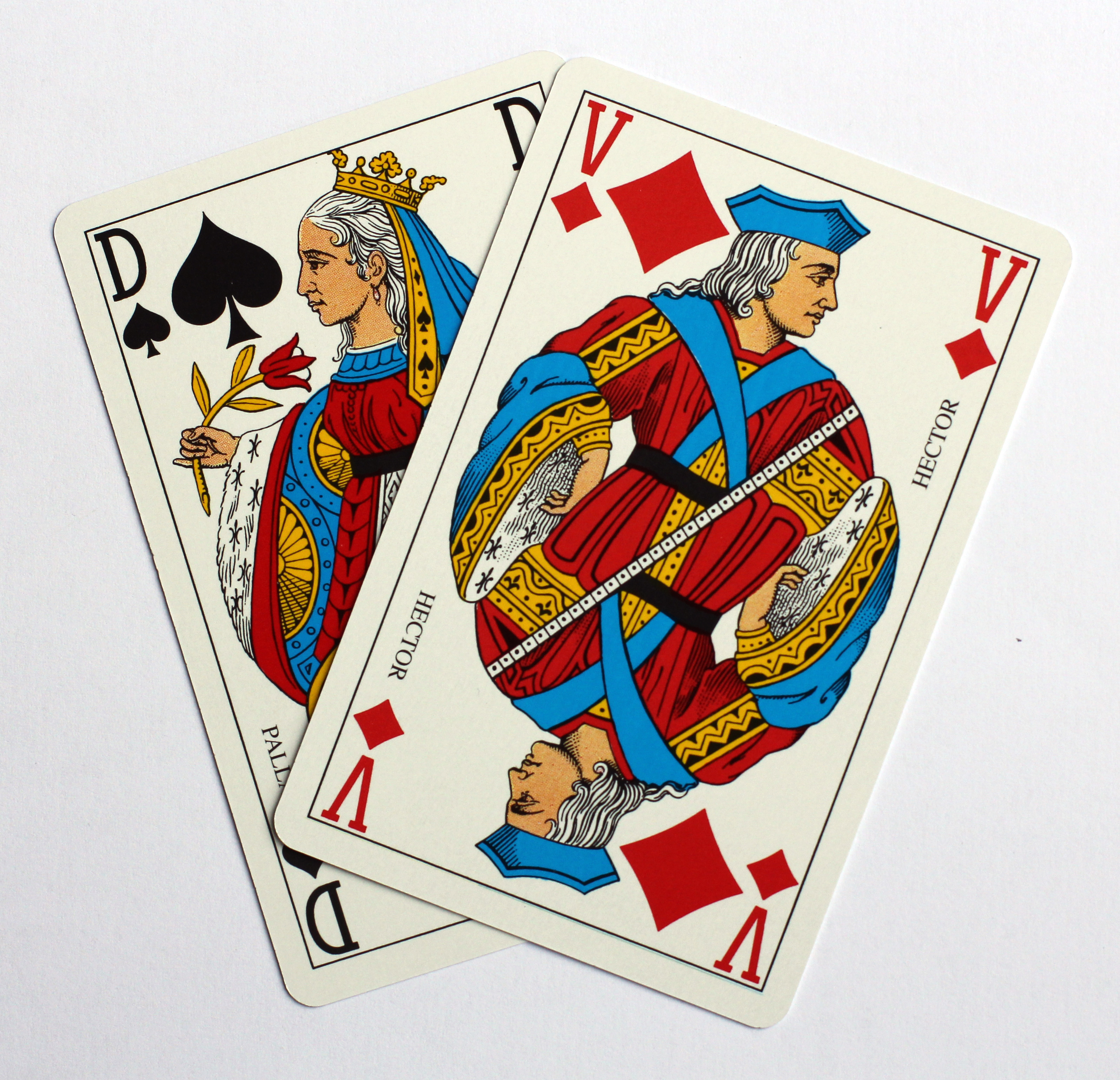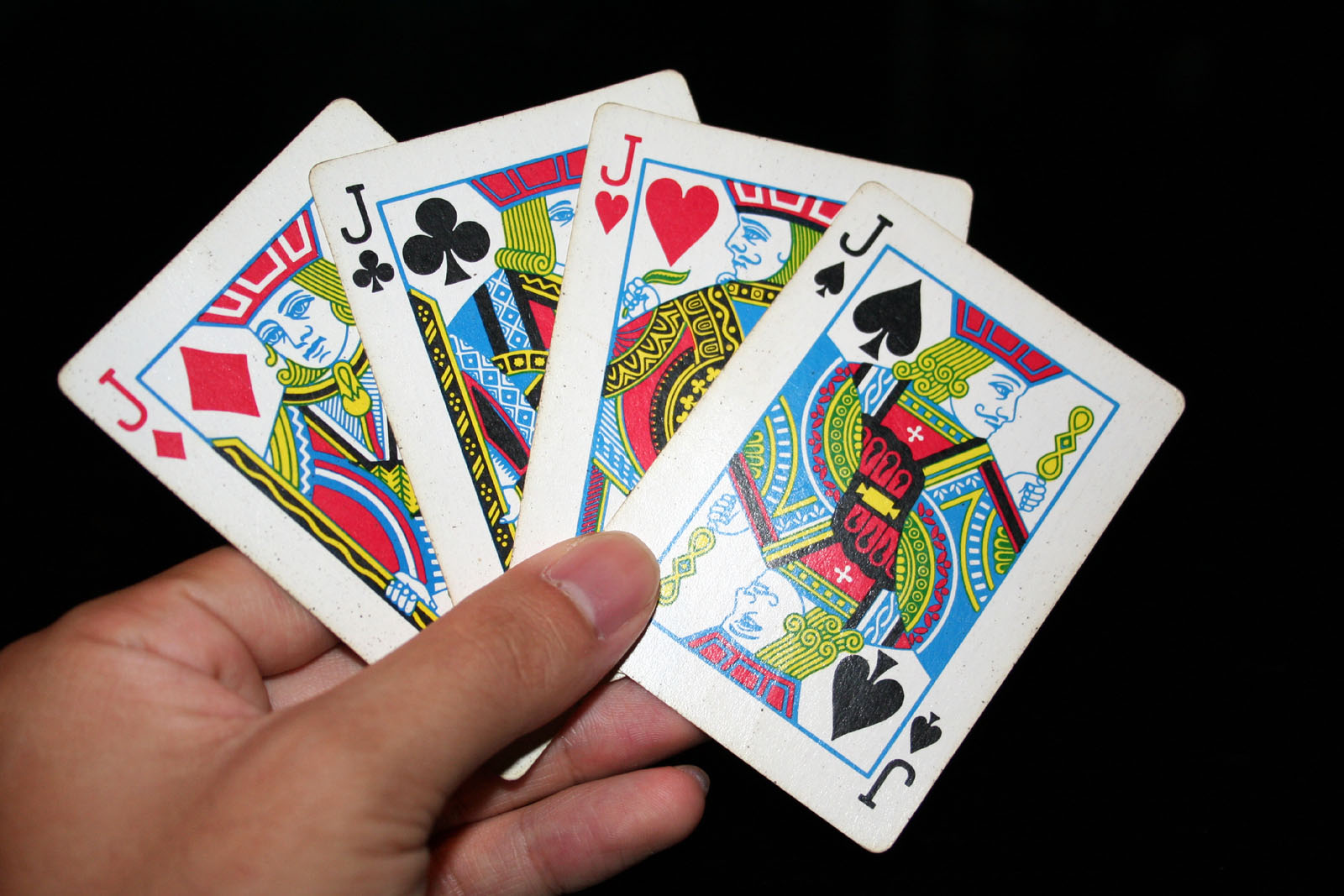|
Pinochle
Pinochle (), also called pinocle or penuchle, is a trick-taking, Ace-Ten card game typically for two to four players and played with a 48-card deck. It is derived from the card game bezique; players score points by trick-taking and also by forming combinations of cards into melds. It is thus considered part of a "trick-and-meld" category which also includes the game belote. Each hand is played in three phases: bidding, melds, and tricks. The standard game today is called "partnership auction pinochle". History Pinochle is thought to have two possible origins. One is that it is a cousin of Binokel, with both games evolving from the game of Bezique. A second alternative is that Pinochle actually developed from the Swiss and, later, South German game of Binocle or Binokel, which in turn is a descendant of Bezique. The word pinochle has several different potential derivations. It may come from the French word ''binocle'' literally meaning "two eyes", or "eyeglasses" or "binocu ... [...More Info...] [...Related Items...] OR: [Wikipedia] [Google] [Baidu] |
Trick-taking
A trick-taking game is a card or tile-based game in which play of a '' hand'' centers on a series of finite rounds or units of play, called ''tricks'', which are each evaluated to determine a winner or ''taker'' of that trick. The object of such games then may be closely tied to the number of tricks taken, as in plain-trick games such as contract bridge, whist, and spades, or to the value of the cards contained in taken tricks, as in point-trick games such as pinochle, the tarot family, briscola, and most evasion games like hearts. Trick-and-draw games are trick-taking games in which the players can fill up their hands after each trick. In most variants, players are free to play any card into a trick in the first phase of the game, but must ''follow suit'' as soon as the stock is depleted. Trick-avoidance games like reversis or polignac are those in which the aim is to avoid taking some or all tricks. The domino game Texas 42 is an example of a trick-taking game that is no ... [...More Info...] [...Related Items...] OR: [Wikipedia] [Google] [Baidu] |
Bezique
Bezique () or Bésigue () is a 19th-century French melding and trick-taking card game for two players that came to Britain and is still played today. The game is derived from Piquet,''Transactions of the Philological Society'', Philological Society, pg. 289 - Philological Society (Great Britain) 1910 possibly via Marriage (Sixty-six) and Briscan, with additional scoring features, notably the peculiar liaison of the and that is also a feature of Pinochle, Binokel, and similarly named games that vary by country. History An early theory that appeared in the 1864 edition of ''The American Hoyle'' was that Bezique originated in Sweden as the result of a royal competition. This much repeated, but unsubstantiated, tale is recounted thus: "THE ROYAL GAME OF BÉZIQUE This interesting game is supposed to have originated in Sweden. It is said that during the reign of the First Charles (presumed to mean Charles I of England who reigned from 1625-1649)--a reward having been offered by t ... [...More Info...] [...Related Items...] OR: [Wikipedia] [Google] [Baidu] |
Talon (playing Cards)
A talon (; French for "heel") in card games is a stack of undealt cards that is placed on the table to be used during the actual game. Depending on the game or region, they may also be referred to as the blind, kitty, skat, stock, tapp or widow (US). Description In 1909, Meyers Lexicon described the talon as ''"the cards left over after dealing..."'' In games of chance, such as Pharo it is ''"the stock of cards which the banker draws on"''. The talon is usually a pack of cards, placed face down, in the middle of the card table. In other games, there are however very different variations, for example in Königrufen. Talons may be placed face up or face down. Parlett describes a ''kitty'' as "the pool or pot being played for" or "a dead hand or widow". He also equates ''talon'' to ''stock'' as the "cards which are not dealt initially but may be drawn from or dealt out later in the play."Parlett, David. ''The Penguin Book of Card Games''. London: Penguin (2008), p. 642-646. . Exam ... [...More Info...] [...Related Items...] OR: [Wikipedia] [Google] [Baidu] |
Binokel
Binokel is a card game for two to eight players that originated in Switzerland as Binocle, but spread to the German state of Württemberg, where it is typically played with a Württemberg pattern pack. It is still popular in Württemberg, where it is usually played in groups of three or four as a family game rather than in the pubs. In three-hand games, each player competes for himself, while in four-hand games, known as Cross Binokel (''Kreuzbinokel''), two teams are formed with partners sitting opposite one another. The game was introduced to America by German immigrants in the first half of the 20th century, where it developed into the similar game of pinochle. Binocle was still played in Switzerland in 1994. In south Germany, the game is sometimes called by its Swabian name, Benoggl. [...More Info...] [...Related Items...] OR: [Wikipedia] [Google] [Baidu] |
Marjolet
Marjolet () is a French 6-card trick-and-draw game for two players using a 32-card piquet pack. It is of the Queen-Jack type, and thus a relative of Bezique and Pinochle, albeit simpler. The trump Jack is called the ''marjolet'' from which the name of the game derives. Rules Each player receives 6 cards in batches of 2 or 3. The next card is turned face-up to determine the trump suit and put crosswise under the stock. If it happens to be a seven, the dealer scores 10 points... Eldest hand Card players are those participating in a card game. Various names are given to card players based on their role or position. Position Games of Anglo-American origin In games of Anglo-American origin played in English-speaking countries, ... leads to the first trick. While the stock contains cards, players can play any card they want. Once the stock is depleted they must follow suit, if possible, and win the trick, if possible. A player who cannot follow suit after the stock is dep ... [...More Info...] [...Related Items...] OR: [Wikipedia] [Google] [Baidu] |
Card Game
A card game is any game using playing cards as the primary device with which the game is played, be they traditional or game-specific. Countless card games exist, including families of related games (such as poker). A small number of card games played with traditional decks have formally standardized rules with international tournaments being held, but most are folk games whose rules vary by region, culture, and person. Traditional card games are played with a ''deck'' or ''pack'' of playing cards which are identical in size and shape. Each card has two sides, the ''face'' and the ''back''. Normally the backs of the cards are indistinguishable. The faces of the cards may all be unique, or there can be duplicates. The composition of a deck is known to each player. In some cases several decks are shuffled together to form a single ''pack'' or ''shoe''. Modern card games usually have bespoke decks, often with a vast amount of cards, and can include number or action cards. This ... [...More Info...] [...Related Items...] OR: [Wikipedia] [Google] [Baidu] |
Euchre
Euchre or eucre () is a trick-taking game, trick-taking card game commonly played in Australia, Canada, New Zealand, Great Britain, and the United States. It is played with a deck of 24, 28, or 32 standard playing cards. Normally there are four players, two on each team, although there are euchre game variations, variations for two to nine players. Euchre emerged in the United States in the early 19th century and, while there several theories for its origin, the most likely is that it derives from an old Alsatian game called Juckerspiel, Jucker. Euchre was subsequently responsible for introducing the Joker (playing card), joker into the modern deck of cards, first appearing in Euchre packs in the 1850s. Origins and popularity ''Eucre'' is briefly mentioned as early as 1810 by Piomingo, a Chickasaw chief, being played in a gaming house alongside All Fours (card game), all fours, loo (card game), loo, cribbage and whist. In 1829, ''uker'' was being played with ''bowers'' on a s ... [...More Info...] [...Related Items...] OR: [Wikipedia] [Google] [Baidu] |
Jack (playing Card)
A Jack or Knave, in some games referred to as a bower, is a playing card which, in traditional French and English decks, pictures a man in the traditional or historic aristocratic or courtier dress, generally associated with Europe of the 16th or 17th century. The usual rank of a jack is between the ten and the queen. History The earliest predecessor of the knave was the (second or under-deputy) in the Mamluk card deck. This was the lowest of the three court cards and like all court cards was depicted through abstract art or calligraphy. When brought over to Italy and Spain, the was made into an infantry soldier or page ranking below the knight card. In France, where the card was called the valet, the queen was inserted between the king and knight. The knight was subsequently dropped out of non- Tarot decks leaving the valet directly under the queen. The king-queen-valet format then made its way into England. As early as the mid-16th century the card was known in E ... [...More Info...] [...Related Items...] OR: [Wikipedia] [Google] [Baidu] |
Queen Of Spades
The queen of spades (Q) is one of 52 playing cards in a standard deck: the queen of the suit of spades (). In Old Maid and several games of the Hearts family, it serves as a single, undesirable card in the deck. Roles by game In the Hearts family of card games, the queen of spades is usually considered an unlucky card; it is the eponym of the Black Maria and Black Lady variants of Hearts. The player who ends up with the queen of spades after a match scores 13 points (points are to be avoided in this game). The exception is when the player receives this card with all 13 hearts, in which the player is said to have shot the moon, and this player scores no points, while all opponents are scored 26 points. In the game of Old Maid, while any card can technically be used for this purpose, the queen of spades is traditionally used as a card that has no match, thereby making it the "old maid" card. In the seven card stud poker variant known as "The Bitch", a face-up deal of the quee ... [...More Info...] [...Related Items...] OR: [Wikipedia] [Google] [Baidu] |
Ace-Ten
An Ace-Ten game is a type of card game, highly popular in Europe, in which the Aces and Tens are of particularly high value. Description Many of Europe's most popular card games feature the Ace-Ten scoring system, where the cards count as Ace = 11, Ten = 10, King (playing card), King = 4, Queen (playing card), Queen or Ober (playing card), Ober = 3, Jack (playing card), Jack or Unter (playing card), Unter = 2. Pip cards below the Ten generally have no card point value and the pack is often shortened by removing the lower pip cards or 'non-counters'. This means that, in a typical shortened pack of between 20 and 36 cards, there are 120 card points and thus a winning total is typically 61 points. Wins are doubled for scoring three-quarters of the total points and trebled for winning every trick, a scoring system known as the Skat schedule after its "most illustrious" example, the German national game of Skat (card game), Skat. There are 3 branches of the Ace-Ten family: * Schafkop ... [...More Info...] [...Related Items...] OR: [Wikipedia] [Google] [Baidu] |
Rensselaer County Historical Society
The Rensselaer County Historical Society (RCHS) is a non-profit, historical society and museum, to promote the study of the history of the Rensselaer County, NY. RCHS was founded in 1927, and originally operated out of a single room in the Troy Public Library, collecting manuscripts and published materials related to the county's history. It is located in the Central Troy Historic District, in Troy, NY. The Rensselaer County Historical Society operates a museum, and offers public programs from its location at 57 Second Street, Troy, NY. Incorporation RCHS was incorporated to: # Promote and encourage historical research, # Disseminate a greater knowledge of the early history of that portion of the State of New York known as Rensselaer County, # Gather and preserve books, manuscripts, papers and relics relating to the early history of Rensselaer County and the contiguous territory, # Suitably mark places of historic interest, and acquire by purchase, gift, devise or otherwise ... [...More Info...] [...Related Items...] OR: [Wikipedia] [Google] [Baidu] |









